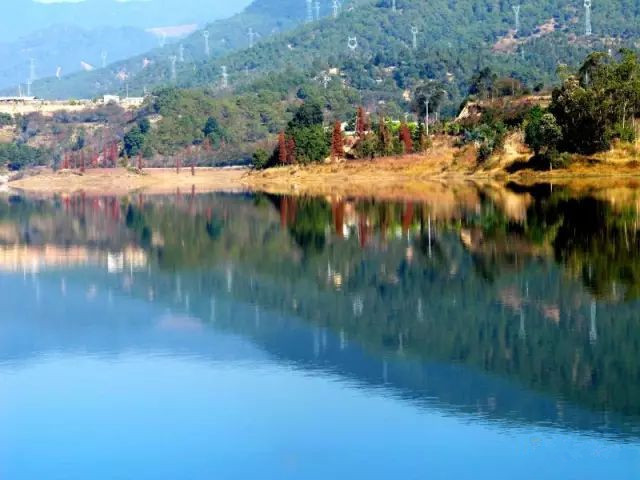Dajiantang Reservior in Yongping County, Dali
Dajiantang Reservoir (大碱塘水库), known as the “Pearl of the Mountain Hollow” (山坳明珠), is located about 2 kilometers northeast of Yongping County (永平县). It serves as the main water source for agricultural irrigation in the town of Laojie (老街镇). The reservoir is surrounded by mountains, creating a picturesque landscape. With trees planted around it, the area is gradually turning into a forest. During winter and spring, the reservoir fills with water, glistening under the sunlight and presenting a stunning view of mountains and water harmoniously combined. Dajiantang Reservoir is an ideal destination for tourism and leisure activities in Yongping.
Yuhuang Pavilion
Yuhuang Pavilion (玉皇阁) is located atop Linghua Mountain (灵化山) in Shijia Village (石家村) of Longmen Township (龙门乡), approximately 5 kilometers from the county seat. Historical evidence suggests that Yuhuang Pavilion was first built during the Wanli period of the Ming Dynasty (明万历年间). According to the “Yongchang Prefecture Chronicles” (《永昌府志》), “a person from Yunlong Prefecture in the Ming Dynasty, Dong Mou (董某), brought the golden statue of the Celestial Master here, but could not lift it, thus he chose the land to build the pavilion.”
The “Yongping County Chronicles Draft” (《永平县志稿》) recorded that the pavilion was later destroyed during wars. In the ninth year of the Guangxu era (清光绪九年), it was restored by the scholar Li Kaiyang (李开阳) and others. The pavilion was spacious, consisting of three sections.
In 1958, Yuhuang Pavilion was demolished during the “Four Olds” campaign, leading to its gradual neglect. However, after 1983, the community in Longmen and Laojie spontaneously organized fundraising efforts to rebuild the pavilion. By 1990, more than ten temples, including the Guanyin Hall (观音殿), Caishen Hall (财神殿), and the Main Hall (大殿), had been completed, creating an impressive sight.
In 1988, Yuhuang Pavilion was listed as a key cultural relic protection unit at the county level.
Notable Inscriptions and Poems
Jian An Yi Xu Gong Gao (剑安以许公高): This poem is known for its superb calligraphy and verses, and further verification of Xu Gong Gao’s identity is needed.
Couplet (对联):
- Inscription: “怪石倒悬侵地隘,长江诸曲傍山多。”
- Translation: “Strange stones hang upside down, encroaching on the narrow land; the bends of the Yangtze River are many beside the mountains.”
- Date: Spring of the Gengshen year in the Jiajing era (嘉靖庚申春), inscribed by the Supervisor Wang Daren (监察御史王大任).
Additionally, there are other inscriptions such as “Tian Shang Xing Qiao (天上星桥)” and “Gong Shi Li Ba (功施利跋)” as well as the “Road Construction Monument (修路碑记)” and “Reconstruction of Baolan Cangjiang Bridge Monument (重修保澜沧江桥碑序)” from the 30th year of Guangxu (光绪三十年, 1904). Some of these are too high to reach or buried, requiring further preservation efforts.
Current Status
On November 25, 2003, an article titled “Concerns About the Fate of Yunnan’s Jihong Bridge and Cliff Inscriptions” (《牵挂云南霁虹桥与摩崖石刻的命运》) was published in the Overseas Edition of the People’s Daily (《人民日报(海外版)》). In early 2004, a survey team from Yunnan Archaeological Research Institute spent two weeks investigating Jihong Bridge and the cliff inscriptions.
In April 2005, Huaneng Group (华能集团), the owner of the Xiaowan Hydropower Station (小湾水电站), announced that it would invest over 30 million yuan to protect the submerged cultural relics and sites, emphasizing the need to preserve the buildings and inscriptions of Jihong Bridge.
By October 2006, the cliff inscriptions near Jihong Bridge remained in a painful state due to erosion from rainwater and human damage. A new road was built for a new bridge, causing mud to cover parts of the cliff inscriptions. The once-visible large characters of “The First Bridge in Southwest” (西南第一桥) were now barely legible.
How to Get There
Transportation Options
By Car: From Dali (大理), drive northeast to Yongping County. The route offers beautiful scenery and various historical sites along the way.
Public Transport: Buses operate between Dali and Yongping, making stops in several towns. Check local schedules for the latest information.
Walking: For the adventurous, hiking paths lead from nearby villages down to the reservoir and pavilion, offering a chance to enjoy the landscape up close.
Travel Tips
- Best Time to Visit: Spring and autumn are ideal seasons to enjoy mild weather and clear views.
- Safety Precautions: Wear sturdy shoes and be cautious while navigating rocky paths and areas near the water.
- Photography: Bring a camera to capture the stunning scenery; early mornings offer the best lighting.
- Local Guides: Consider hiring a local guide to enrich your understanding of the historical significance and stories behind the reservoir and pavilion.

 7 Days GolfingTour
7 Days GolfingTour
 8 Days Group Tour
8 Days Group Tour
 8 Days Yunnan Tour
8 Days Yunnan Tour
 7 Days Shangri La Hiking
7 Days Shangri La Hiking
 11 Days Yunnan Tour
11 Days Yunnan Tour
 6 Days Yuanyang Terraces
6 Days Yuanyang Terraces
 11 Days Yunnan Tour
11 Days Yunnan Tour
 8 Days South Yunnan
8 Days South Yunnan
 7 Days Tea Tour
7 Days Tea Tour
 8 Days Muslim Tour
8 Days Muslim Tour
 12 Days Self-Driving
12 Days Self-Driving
 4 Days Haba Climbing
4 Days Haba Climbing
 Tiger Leaping Gorge
Tiger Leaping Gorge
 Stone Forest
Stone Forest
 Yunnan-Tibet
Yunnan-Tibet
 Hani Rice Terraces
Hani Rice Terraces
 Kunming
Kunming
 Lijiang
Lijiang
 Shangri-la
Shangri-la
 Dali
Dali
 XishuangBanna
XishuangBanna
 Honghe
Honghe
 Kunming
Kunming
 Lijiang
Lijiang
 Shangri-la
Shangri-la
 Yuanyang Rice Terraces
Yuanyang Rice Terraces
 Nujiang
Nujiang
 XishuangBanna
XishuangBanna
 Spring City Golf
Spring City Golf
 Snow Mountain Golf
Snow Mountain Golf
 Stone Mountain Golf
Stone Mountain Golf














